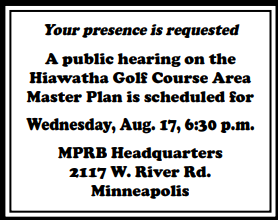 BY ED FELIEN
BY ED FELIEN
Ian Young, in a Star Tribune editorial published Aug. 5, said, “Those commissioners voting to advance the nine-hole master plan are the ones who have done their homework and understand the reality of the issue.”
Really?
Young says any proposal to save Hiawatha Golf Course would “not be compatible with the other major goals for the site: managing flooding, reducing groundwater pumping and cleaning up pollution entering the lake.”
The 2017 Barr Engineering study said removing the remains of the dam/weir at 27th Avenue and an unused gas utility pipe would reduce the level of Lake Hiawatha by one and a half feet. Lake Hiawatha is 53.5 acres. An acre is 43,560 square feet. 43,560 times 53.5 means 2,330,460 square feet, times 1.5 would equal 3,495,690 cubic feet. One cubic foot of water contains 7.48 gallons. 7.48 gallons times 3,495,690 equals 26,147,761 gallons of water.
Getting the Park Board to take down the remains of the dam/weir and getting CenterPoint Energy to remove their unused utility pipe would mean we would increase Lake Hiawatha’s storm water capacity by 26 million gallons. That would go a long way toward “managing flooding” and “reducing groundwater pumping.”
“Cleaning up pollution entering the lake” is the responsibility of the city. Most of the trash comes through the storm sewer system that takes gutter trash from Lake Street to 43rd Street, from Chicago Avenue over to 27th Avenue, and dumps it into Lake Hiawatha. Andrew Johnson, chair of the city’s Public Works Committee, has shared with me that there is grant funding secured to implement a temporary litter catchment next year.
If for some perverse reason the Park Board refuses to take down the remains of the dam/weir, and CenterPoint refuses to remove their unused utility pipe, then people should write to Sarah Strommen, commissioner of the Minnesota DNR, and complain that the Park Board and CenterPoint are blocking the natural flow of Lake Hiawatha into Minnehaha Creek.
My understanding of regulations is that: “Federally-owned dams and dams determined by the DNR to be non-hazardous are exempt from the dam safety rules. Dams not subject to the dam safety rules will still require state and federal permits if they involve filling of public waters or wetlands.”
Backing up a foot and a half of water raises the water table in the surrounding protected wetlands. The peat soil conducts water easily and collapses sidewalks and floods basements.
They must have a permit to do what they are doing.
Do they have a permit to flood a wetland?
If they don’t have a permit, then they’re in violation of State Law: 103G.141.
And, if necessary, they should be prosecuted in a court of law.
“I believe the City has the responsibility to eliminate pollution entering Lake Hiawatha from our infrastructure. Litter comes through the storm water system from miles of roadway and dumps into the lake. We are exploring permanent infrastructure changes to address this, and once recommendations are before us we will be able to proceed with securing funding so that we can get permanent improvements implemented. In the meantime, we are implementing temporary improvements to help catch litter for removal.” – Andrew Johnson, Chair of Public Works & Infrastructure






















